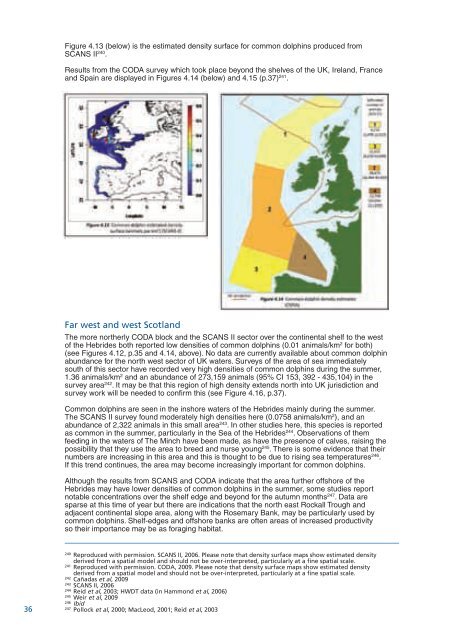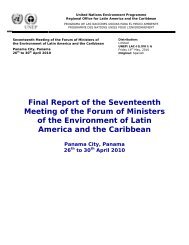Figure 4.13 (below) is the estimated density surface for common dolphins produced fromSCANS II 240 .Results from the CODA survey which took place beyond the shelves of the UK, Ireland, Franceand Spain are displayed in Figures 4.14 (below) and 4.15 (p.37) 241 .Far west and west ScotlandThe more northerly CODA block and the SCANS II sector over the continental shelf to the westof the Hebrides both reported low densities of common dolphins (0.01 animals/km 2 for both)(see Figures 4.12, p.35 and 4.14, above). No data are currently available about common dolphinabundance for the north west sector of UK waters. Surveys of the area of sea immediatelysouth of this sector have recorded very high densities of common dolphins during the summer,1.36 animals/km 2 and an abundance of 273,159 animals (95% CI 153, 392 - 435,104) in thesurvey area 242 . It may be that this region of high density extends north into UK jurisdiction andsurvey work will be needed to confirm this (see Figure 4.16, p.37).Common dolphins are seen in the inshore waters of the Hebrides mainly during the summer.The SCANS II survey found moderately high densities here (0.0758 animals/km 2 ), and anabundance of 2,322 animals in this small area 243 . In other studies here, this species is reportedas common in the summer, particularly in the Sea of the Hebrides 244 . Observations of themfeeding in the waters of The Minch have been made, as have the presence of calves, raising thepossibility that they use the area to breed and nurse young 245 . There is some evidence that theirnumbers are increasing in this area and this is thought to be due to rising sea temperatures 246 .If this trend continues, the area may become increasingly important for common dolphins.Although the results from SCANS and CODA indicate that the area further offshore of theHebrides may have lower densities of common dolphins in the summer, some studies reportnotable concentrations over the shelf edge and beyond for the autumn months 247 . Data aresparse at this time of year but there are indications that the north east Rockall Trough andadjacent continental slope area, along with the Rosemary Bank, may be particularly used bycommon dolphins. Shelf-edges and offshore banks are often areas of increased productivityso their importance may be as foraging habitat.36240Reproduced with permission. SCANS II, 2006. Please note that density surface maps show estimated densityderived from a spatial model and should not be overinterpreted, particularly at a fine spatial scale.241Reproduced with permission. CODA, 2009. Please note that density surface maps show estimated densityderived from a spatial model and should not be overinterpreted, particularly at a fine spatial scale.242Cañadas et al, 2009243SCANS II, 2006244Reid et al, 2003; HWDT data (in Hammond et al, 2006)245Weir et al, 2009246Ibid247Pollock et al, 2000; MacLeod, 2001; Reid et al, 2003
South west EnglandBased on observations of seasonal patterns in sightings data, common dolphins are thought toshow a general movement into offshore waters during the summer months. Their occurrence andrange in offshore waters is still poorly understood but the recent CODA survey (in July, 2007) whichtook place beyond the shelves of the UK, Ireland, France and Spain, has contributed to our knowledge.Conducted at the same time of year as the SCANS surveys to allow comparison, CODA recorded adensity of 0.159 animals/km 2 (CV 0.54) in the block off the shelf to the south west of the UK (seeFigure 4.14, p.36). This is more than twice that recorded for the adjacent, on-shelf SCANS sector(0.056 animals/km 2 ) (see Figure 4.12, p.35), seeming to support the idea of an offshore movementduring the summer. Spatial modelling of the CODA data predicted a high density area along thecontinental slope (see Figure 4.15, above). Common dolphins have been noted in the past to beassociated with areas of high topographic relief 248 .The apparent movement into offshore waters during the summer is likely prey-driven and it hasbeen hypothesised that movement out of Celtic Sea waters may be connected to the summerspawning of fish 249 . Many species of fish (such as sprat and Atlantic horse mackerel) spawn in theCeltic Sea and during this time, their lipid content decreases significantly, reducing their value asprey species to common dolphins 250 . This occurs at the same time that common dolphins give birthand nurse their young (May to September), a time when females particularly require high calorificprey. By migrating to offshore areas they may be able to prey on lipid-rich myctophid prey (whichthey have been documented to feed on in offshore waters), and meet these calorific demands moreeffectively 251 . The high proportion of females and young calves bycaught in the Irish offshore tunadriftnet fishery at this time of year lends further weight to this suggestion 252 .It is clear though, that even if a large proportion of the population move into offshore waters, not alldo. Encounter rates during the summer are still quite high off south west England 253 and SCANS II(in July, 2005) recorded the second highest density of common dolphins in the survey for the<strong>English</strong> Channel (0.1159 animals/km 2 ) 254 (see Figure 4.12, p.35). Spatial modelling of this datapredicted an area of high density in the western part of the Channel, from the Channel Islandsnear north west France, north to almost the south west Devon coast (see Figure 4.13, p.36).This supports the findings of previous studies in this area during the summer 255 .248Hui, 1979; Evans et al, 2003249Brophy et al, 2009,250Ibid251Ibid252Murphy and Rogan, 2006 (in Brophy et al, 2009)253Reid et al, 2003; Evans et al, 2003254SCANS II, 2006255Kiszka et al, 2007; Rosen et al, 200037
- Page 1 and 2: WDCS, the Whale and Dolphin Conserv
- Page 3 and 4: Towards Marine ProtectedAreas for C
- Page 5 and 6: South west EnglandCeltic Deep - com
- Page 7 and 8: CONTENTSExecutive Summary 2Acknowle
- Page 9 and 10: 1. INTRODUCTIONWe enter an exciting
- Page 11 and 12: Note: This schematic map shows thev
- Page 13 and 14: 2. IDENTIFYING MARINE PROTECTED ARE
- Page 15 and 16: 3. CRITICAL HABITATInterest in the
- Page 17 and 18: Foraging, travel, socialising and p
- Page 19 and 20: 4. DATA AND SPECIES ACCOUNTSIn orde
- Page 21 and 22: Killer whale (Orcinus orca)Atlantic
- Page 23 and 24: 4.4 SPECIES ACCOUNTS4.4.1 HARBOUR P
- Page 25 and 26: Although there is some variation in
- Page 27 and 28: North ScotlandThe first SCANS surve
- Page 29 and 30: East EnglandThe seasonal pattern in
- Page 31 and 32: Irish SeaOutside of coastal Welsh w
- Page 33 and 34: 4.4.2 BOTTLENOSE DOLPHIN (Tursiops
- Page 35 and 36: This expansion in range means this
- Page 37: 4.4.3 SHORTBEAKED COMMON DOLPHIN (D
- Page 41 and 42: 4.4.4 COMMON MINKE WHALE (Balaenopt
- Page 43 and 44: Sightings for this area of the Oute
- Page 45 and 46: The JNCC Atlas of cetacean distribu
- Page 47 and 48: 4.4.5 WHITEBEAKED DOLPHIN (Lagenorh
- Page 49 and 50: 4.4.6 RISSO'S DOLPHIN (Grampus gris
- Page 51 and 52: 4.4.7 KILLER WHALE OR ORCA (Orcinus
- Page 53 and 54: 4.4.8 ATLANTIC WHITESIDED DOLPHIN (
- Page 55 and 56: 4.4.9 LONGFINNED PILOT WHALE (Globi
- Page 57 and 58: 4.4.10 SPERM WHALE (Physeter macroc
- Page 59 and 60: 4.4.11 BEAKED WHALESNORTHERN BOTTLE
- Page 61 and 62: which looked at worldwide beaked wh
- Page 63 and 64: There is no current population esti
- Page 65 and 66: 4.5 SCOTTISH MPA GUIDELINES - STAGE
- Page 67 and 68: Northern bottlenose whale and Sower
- Page 69 and 70: Fisheries BycatchFisheries bycatch
- Page 71 and 72: 5.2 AN OVERVIEW OF REGIONAL THREATS
- Page 73 and 74: North ScotlandAs in the west, threa
- Page 75 and 76: 6. IDENTIFYING CRITICAL HABITAT IN
- Page 77 and 78: 6.1.1 HARBOUR PORPOISEWest and sout
- Page 79 and 80: Assessment: Critical HabitatHigh re
- Page 81 and 82: 11. Area: Off Land's End, Cornwall
- Page 83 and 84: Threats, status and relative import
- Page 85 and 86: East Scotland3. Area: North east Sc
- Page 87 and 88: Threats, status and relative import
- Page 89 and 90:
6.1.4 COMMON MINKE WHALEWest and so
- Page 91 and 92:
6.1.5 WHITEBEAKED DOLPHINWest and s
- Page 93 and 94:
Coastal Wales2. Area: Bardsey Islan
- Page 95 and 96:
6.1.8 ATLANTIC WHITESIDED DOLPHINNo
- Page 97 and 98:
Other areasOne other area was asses
- Page 99 and 100:
6.1.11 BEAKED WHALESThe northern Ro
- Page 101 and 102:
7. PROTECTING CRITICAL HABITAT - RE
- Page 103 and 104:
considered in the area, each of whi
- Page 105 and 106:
7.4 EAST SCOTLANDWithin the east Sc
- Page 107 and 108:
7.5 SOUTH WEST ENGLANDWithin the so
- Page 109 and 110:
An SAC is already in place for bott
- Page 111 and 112:
7.9 SUMMARYFour areas of identified
- Page 113 and 114:
iv. Licensing processes for industr
- Page 115 and 116:
9. IDENTIFICATION AND PRIORITISATIO
- Page 117 and 118:
Recommendations on particular data
- Page 119 and 120:
Coastal Wales northern Pembrokeshir
- Page 121 and 122:
ANNEX II SPECIES ACCOUNTS SUMMARY
- Page 123 and 124:
HARBOUR PORPOISEEast ScotlandStudyH
- Page 125 and 126:
HARBOUR PORPOISESouth West EnglandS
- Page 127 and 128:
HARBOUR PORPOISECoastal WalesStudyT
- Page 129 and 130:
BOTTLENOSE DOLPHINStudyTemporalReso
- Page 131 and 132:
SHORTBEAKED COMMON DOLPHINStudyTemp
- Page 133 and 134:
SHORTBEAKED COMMON DOLPHINStudyTemp
- Page 135 and 136:
COMMON MINKE WHALEWest ScotlandStud
- Page 137 and 138:
WHITEBEAKED DOLPHINStudyTemporalRes
- Page 139 and 140:
KILLER WHALEStudyTemporalResolution
- Page 141 and 142:
ATLANTIC WHITESIDED DOLPHINStudyTem
- Page 143 and 144:
SPERM WHALEStudyTemporalResolutionS
- Page 145 and 146:
BALEEN WHALESStudyTemporalResolutio
- Page 147 and 148:
ANNEX III THREATS TO CETACEANS - RE
- Page 149 and 150:
Actual orPotential ThreatActivitySp
- Page 151:
North ScotlandSpecies of most relev
- Page 156 and 157:
East EnglandSpecies of most relevan
- Page 158 and 159:
South East EnglandSpecies of most r
- Page 160 and 161:
South West EnglandSpecies of most r
- Page 162 and 163:
Irish SeaSpecies of most relevance
- Page 164 and 165:
Actual orPotential ThreatActivitySp
- Page 166 and 167:
Bravington, M., Borchers, D. and No
- Page 168 and 169:
Evans, P.G.H. and Anderwald, P. 200
- Page 170 and 171:
ICES WGMME. 2006. Report of the Wor
- Page 172 and 173:
ECS/ASCOBANS/ACCOBAMS Workshop held
- Page 174 and 175:
marine protected areas effective to
- Page 176:
ISBN: 9781901386233
















